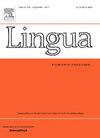Resolving homophonous ambiguity in Mandarin adverbs: Contextual constraints and bidirectional optimization
IF 1.3
3区 文学
0 LANGUAGE & LINGUISTICS
引用次数: 0
Abstract
This study examines homophonous ambiguity in Mandarin adverbs, particularly their ability to function as speaker-oriented, subject-oriented, and manner modifiers. The ambiguity arises when an adverb can be interpreted in multiple ways within the same sentence. In neutral contexts, these interpretations can coexist without contradiction; however, when contextual information highlights conflicts between them, sentences often become semantically incoherent. By analyzing sentence acceptability ratings and interpretation consistency provided by native Mandarin speakers, the data reveal that conflicting contextual cues lead to interpretive conflict and reduced comprehensibility. The study applies Bidirectional Optimality Theory (BiOT) to model how syntactic and semantic constraints interact to produce and interpret ambiguous adverbial structures. BiOT explains how conflicting interpretations compete and how listeners resolve ambiguity by filtering out incoherent readings. The findings suggest that Mandarin speakers rely on lexico-pragmatic association, contextual expansion, and pragmatic inference to navigate ambiguity, and that speaker-oriented adverbs play a crucial role in structuring discourse. This study contributes to linguistic theory by offering a formalized approach to Mandarin adverbial modification and ambiguity resolution, highlighting the role of context and discourse in meaning selection.
汉语副词同音歧义的消解:语境约束与双向优化
本研究考察了汉语副词中的同音歧义,特别是它们作为说话人导向、主语导向和方式导向的能力。当一个副词在同一个句子中可以有多种解释时,歧义就产生了。在中性语境中,这些解释可以共存而没有矛盾;然而,当上下文信息强调它们之间的冲突时,句子往往变得语义不连贯。通过分析以普通话为母语的人提供的句子可接受度评分和口译一致性,数据表明语境线索冲突导致口译冲突和可理解性降低。本研究运用双向最优性理论(BiOT)来模拟句法和语义约束如何相互作用产生和解释歧义状语结构。BiOT解释了相互矛盾的解释是如何相互竞争的,以及听众是如何通过过滤掉不连贯的阅读来解决歧义的。研究结果表明,汉语使用者通过词汇语用关联、语境扩展和语用推理来引导歧义,并且以说话人为导向的副词在语篇结构中起着至关重要的作用。本研究为汉语状语修饰和歧义消解提供了一种形式化的方法,强调了语境和话语在意义选择中的作用,从而为语言学理论做出了贡献。
本文章由计算机程序翻译,如有差异,请以英文原文为准。
求助全文
约1分钟内获得全文
求助全文
来源期刊

Lingua
Multiple-
CiteScore
2.50
自引率
9.10%
发文量
93
审稿时长
24 weeks
期刊介绍:
Lingua publishes papers of any length, if justified, as well as review articles surveying developments in the various fields of linguistics, and occasional discussions. A considerable number of pages in each issue are devoted to critical book reviews. Lingua also publishes Lingua Franca articles consisting of provocative exchanges expressing strong opinions on central topics in linguistics; The Decade In articles which are educational articles offering the nonspecialist linguist an overview of a given area of study; and Taking up the Gauntlet special issues composed of a set number of papers examining one set of data and exploring whose theory offers the most insight with a minimal set of assumptions and a maximum of arguments.
 求助内容:
求助内容: 应助结果提醒方式:
应助结果提醒方式:


